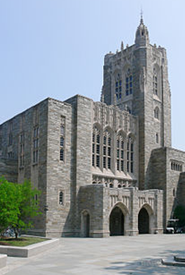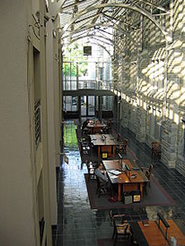

Exterior of Firestone Library

Interior of Firestone Library
Princeton University Library is the main library system of Princeton University. With holdings of more than 7 million books, 6 million microforms, and 48,000 linear feet of manuscripts,[1] it is headquartered in theHarvey S. Firestone Memorial Librarybuilding, named after tire magnate Harvey Firestone.
Firestone Library
Firestone Library opened in 1948, as the first large American university library constructed after World War II.[2] Roughly 1.5 million volumes were moved during the summer of 1948 from East Pyne Hall, which until then had served as the University's main library. The library building was expanded in 1971 and again in 1988 and currently has more than 70 miles (110 km) of bookshelves,[3] making Firestone one of the largest open-stack libraries in existence.[4] Though not the largest university library in the world, the library has more books per enrolled student than that of any other university in the United States.[5]
The Firestone building itself does not appear very large from the outside, because most of its books are stored in three partially underground levels that extend beyond the footprint of the main building. Firestone has four smaller above-ground floors, the second and fourth of which are accessible only to library staff. Princeton's book collection has outgrown Firestone's present capacity. Therefore, volumes relating to many academic subjects are no longer housed at Firestone, but at approximately a dozen other library buildings or spaces located around the campus.
Firestone contains many study spaces, most prominently the Trustee Reading Room (an open study space bounded on one side by glass panels containing the names of all present and past university trustees and presidents) and the atrium. It also has hundreds of carrels (offices about the size of a large closet) that are reserved for faculty, graduate students, and undergraduate seniors working on their theses. Many academic departments also maintain seminar and study rooms within Firestone.
Special Collections
In addition to its open-stack collections, Firestone also houses the Department of Rare Books and Special Collections, The Scheide Library, a social science data center, and a variety of library services.
Lewis Science Library
Lewis Science Library, designed by Frank Gehry, is the campus' newest library building, having opened in the Fall of 2008. Lewis consolidates research collections and staff for the physical and life sciences, as well as maps and geospatial information.
Other Libraries
Other campus libraries include Marquand Library of Art and Archaeology, East Asian Library and the Gest Collection, Stokes Library (for Public and International Affairs & Population Research), Mendel Music Library, Seeley G. Mudd Manuscript Library, Architecture Library, Engineering Library, and the Furth Plasma Physics Library. In addition, two annexes, the Forrestal Annex (Annex A) and ReCAP (Research Collections and Preservation Consortium) are located in the Princeton University Forrestal campus are used to store volumes and materials that are less frequently used. [6]
Access to library services
Currently only registered students, alumni, university faculty, staff, their spouses, domestic partners and dependents, students of Princeton Theological Seminary, theInstitute for Advanced Study and visiting faculty are permitted open (free) access and borrowing privileges in the Princeton University library system. In general, non-university patrons may use the library for research but are not given borrowing privileges and must purchase an access card in order to enter and use the library facilities.[7][8]
References
1. ^ Princeton Profile 2011-2012
2. ^ Princeton University Library History
3. ^ Princeton History at a Glance
4. ^ Princeton University Undergraduate Announcement 2011-2012
5. ^ National Center for Education Statistics: Library Statistics Program
6. ^ "Princeton University Library". Other Libraries. Retrieved 18 February 2012.
7. ^ Princeton University Library Access Policies
8. ^ Princeton University Library Circulation Policies



















